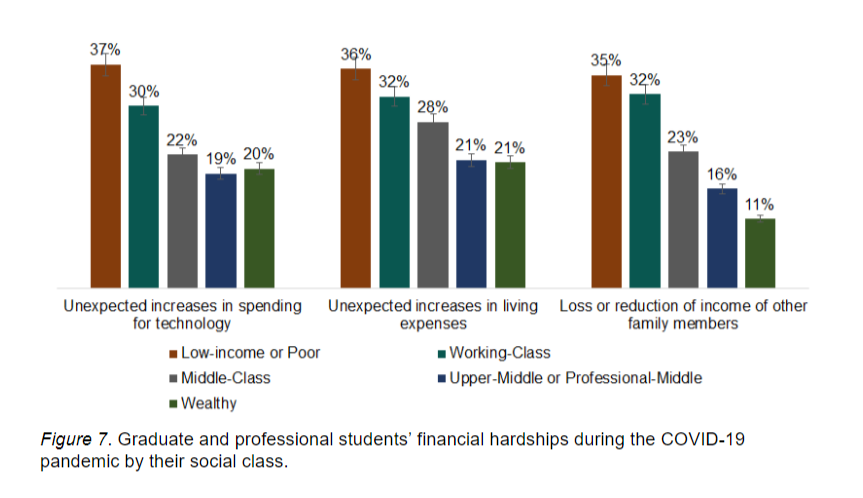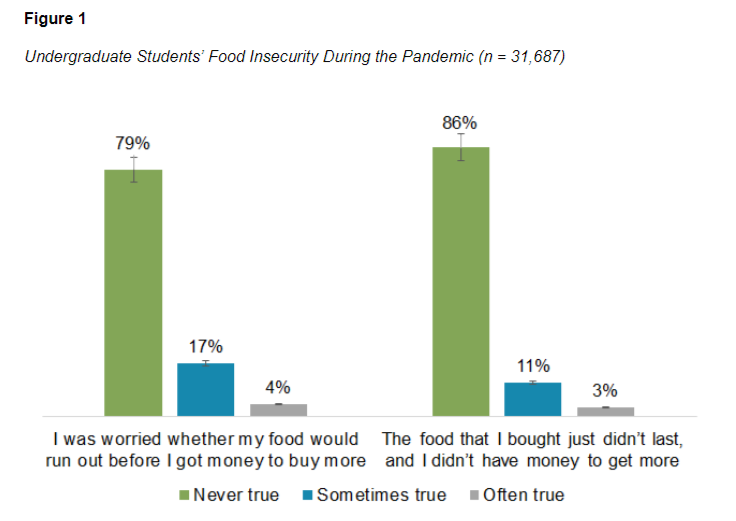You have /5 articles left.
Sign up for a free account or log in.

istock.com/JNemchinova
Students of color and those from lower socioeconomic backgrounds have been more likely to suffer hardships as a result of the coronavirus pandemic and are in need of support from their colleges, a new survey of students at large, public research institutions found.
The Student Experience in the Research University Consortium conducted a comprehensive survey of undergraduate, graduate and professional students from May to July that asked a series of questions about the impact of the coronavirus pandemic on their academic and personal lives. The survey, which received responses from about 30,000 undergraduates and 15,000 graduate and professional students, measured student mental health, financial stability, food and housing insecurity, and their ability to adjust to online learning in the spring, when campuses shut down due to the pandemic.
About 26 percent of undergraduate students said they lost wages from an off-campus job, and 18 percent lost wages from a campus job, according to survey results. About 36 percent of these students also said their families experienced a loss or reduction in income since the pandemic began, and 21.7 percent of graduate and professional students said a family member had reduced income, the survey results said.
Both undergraduate (34.3 percent) and graduate and professional students (26.9 percent) said they had unexpected living expenses during the pandemic, survey results said. Krista Soria, assistant director for research and strategic partnerships for the SERU Consortium who helped lead the survey and analysis, said the unexpected living expenses could be explained by the need for students to relocate from their colleges after the pandemic was declared and colleges shut down campuses and switched to remote instruction.
Igor Chirikov, director of the SERU Consortium and senior researcher for the Center for Studies in Higher Education at the University of California, Berkeley, where Soria is also a research associate, said the analysis of students attending 10 large public research universities from throughout the United States is “very representative” of the student experience at these specific types of universities. It also has one of the largest sample sizes seen among other coronavirus-related surveys of students, Chirikov said. But the results may not be applicable to other types of institutions, such as liberal arts colleges or community colleges, he said.
One of the most important and concerning takeaways from the data was the heightened impact that the pandemic has had on students of color, Indigenous, low-income and working-class students compared to their white and wealthier peers in most areas of the survey, said Soria, who is also director of student affairs assessment for the University of Minnesota Office of Institutional Research and Office of Student Affairs.
By and large, students of color and low-income and working-class students were more likely to have anxiety and depression and to experience food and housing insecurity during the pandemic, and disparities were “remarkably” consistent across both undergraduate and graduate and professional students, Soria said.
 Low-income and working-class students also had higher rates of financial hardship in general, including loss of wages from off-campus employment, loss of an expected job or internship and more unexpected costs for technology and living expenses, Soria said. Nearly two-thirds of low-income students and 54 percent of working-class students also had a family member that experienced a loss of income, compared to 36 percent of middle-class and 24 percent of upper-middle-class students, according to a survey report based on an analysis of students' socioeconomic status.
Low-income and working-class students also had higher rates of financial hardship in general, including loss of wages from off-campus employment, loss of an expected job or internship and more unexpected costs for technology and living expenses, Soria said. Nearly two-thirds of low-income students and 54 percent of working-class students also had a family member that experienced a loss of income, compared to 36 percent of middle-class and 24 percent of upper-middle-class students, according to a survey report based on an analysis of students' socioeconomic status.
“Because those students are already so pinched financially, whereas wealthy students and middle- and upper-class students could maybe rebound from those unexpected increases more successfully than students of those lower [income] and working-class backgrounds, they were much more likely to be really compromised by those things as they were happening,” Soria said.
Some degree of increased financial instability among students who were already struggling financially was to be expected given the widespread impact that the pandemic has had on the nation’s economy, Soria said. But some survey results, such as the level of food insecurity among all students surveyed, were “alarming,” especially because the sample of students was all from large, public research institutions, which tend to enroll more students from middle-class and higher socioeconomic backgrounds, Soria said. 
These students made up a majority of the student sample, and yet 22 percent of undergraduate students and 19 percent of graduate and professional students indicated that they were food insecure during the pandemic, a survey report said.
Soria said she and the consortium hope the survey results and analyses can help college leaders make better decisions on how to assist students through hardships related to the pandemic, such as by providing increased mental health counseling services through telehealth, or food delivery services for students who live near the campuses, or by extending job and internship resources to students’ family members. The data give both administrators and faculty members a better sense of what students might be dealing with in their personal lives and may lead to more compassion or outreach from professors to students in their classes, Soria said.
“If students are not well, not only physically, but mentally, if they are not living in a safe space or don’t have access to nutrition, if they can’t pay their bills, those are the things I care about most as a faculty member this semester,” Soria said. “It’s about a change in perspective, having a philosophical shift of mind, to really be more ethically devoted to students and caring and compassionate to students.”
Soria and Chirikov will be presenting the survey’s findings at two upcoming webinars, one with the NASPA: Student Affairs Administrators in Higher Education Center for First-Generation Student Success on Oct. 1 and also on Oct. 6 as part of the American College Personnel Association’s 2020 virtual webinar series.








